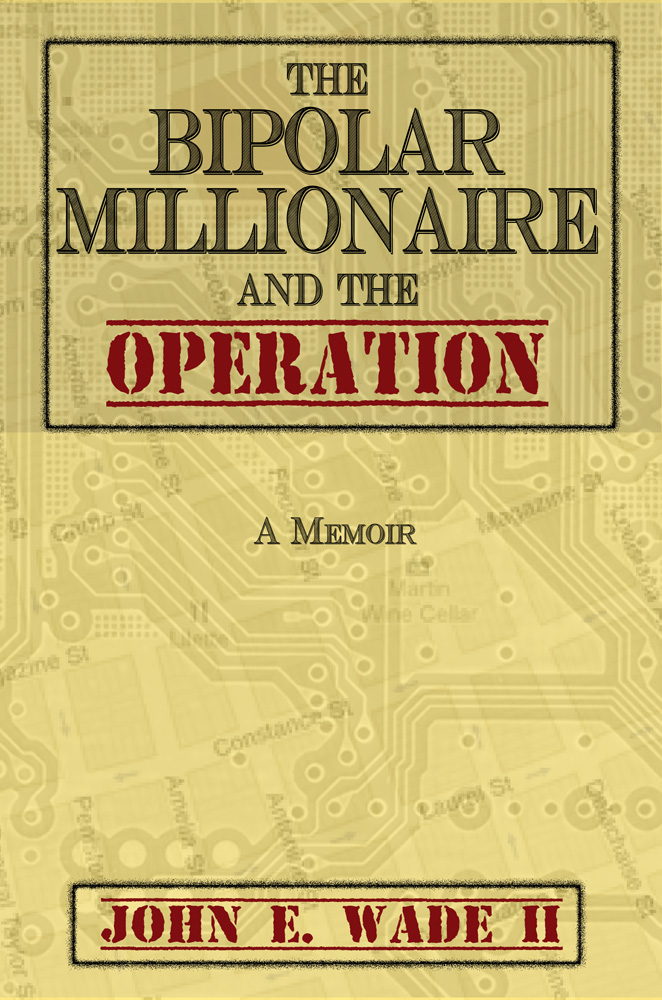 John E. Wade II, retired CPA, author, investor, television producer, and philanthropist, reveals in his memoir, The Bipolar Millionaire and the Operation, his personal struggle with bipolar disorder and his experience being the focus of an all-encompassing and benevolent entity he calls the Operation.
John E. Wade II, retired CPA, author, investor, television producer, and philanthropist, reveals in his memoir, The Bipolar Millionaire and the Operation, his personal struggle with bipolar disorder and his experience being the focus of an all-encompassing and benevolent entity he calls the Operation.*******
I was struggling and dropped into a walk from the jog required of fourth classmen. It was an autumn day in 1963, just a month after I’d had a near-fatal attack of meningitis, and I was still fighting to regain my strength. Panting for breath, I was confronted by a first classman. He asked very directly why I wasn’t jogging. I quickly replied that I had a medical excuse, knowing full well that the excuse had expired. He ordered me to produce the excuse, which I did. Noting its date, he nonetheless allowed me to proceed.
Soon, I was in the academy hospital, lying flat on my back in an almost catatonic state, unable to cope with my mental torment. Although this severe depression, the first in my life, was not diagnosed at the time, it must have been my first bipolar episode, possibly having been triggered by the recent attack of meningitis.
My mother and Carol, my then-girlfriend, came to try to revive me, but I don’t remember responding. Years later, Carol told me that I asked her to help me kill myself, but I have absolutely no memory of making such a request.
Until this illness I had been a model cadet. I had prepared physically according to academy guidelines, so the transition to basic cadet summer was rigorous but easier than it would have been without vigorous training.
One other thing that helped me during basic cadet summer was the stream of daily letters from Carol. My fellow cadets were jealous, partly because of the letters, but also because of the picture of her I had in my room. Even though it was black and white, it was clear that she had blond hair, a sweet smile, and a pleasing, pretty face. That face helped me get through the rest of what we all had to endure to complete our training.
Each week we were given certain “knowledge” to learn, such as types of aircraft or chains of command. I always spent part of Sunday afternoon memorizing the information so that I could recite it during Monday’s meals. The upperclassmen pointedly asked several questions of each basic cadet, which kept us from finishing our entire meal. The first classmen took turns performing the interrogation, but as the questions were considerably shorter than the answers, they always had plenty of time to eat. I always felt I was short-changed because I was the only one who knew the trivia from the first day it was due, and yet I didn’t get a chance to eat more than the other basic cadets.
At the end of basic cadet summer, all the cadets were subjected to a physical fitness test, and I scored the highest in my squadron. At about the same time, we also went on a survival exercise in the mountains for which we were organized into small groups with twenty-four hours’ worth of food and about a week’s time to find our way back to the academy. The experience was particularly taxing for me. I became so obsessed with saving my food that I still had some left when we got back to the academy.
After the final tests, those of us who successfully completed basic cadet summer became fourth classmen. My personal excitement was not long lasting, however. Although I had scored high marks on the physical tests, I was disappointed with my first academic grades, which included some Bs, as I was used to all As in high school. When I asked a first classman for his opinion, he said I did just fine considering that I came from a weak high school.
Basic cadet summer had ended—then the meningitis hit. I’ve since read that physical illness can trigger the onset of bipolar disorder, and although the diagnosis was not made at that time, I believe that is what had happened. My father eventually was diagnosed as having bipolar disorder also, so it appears that I was genetically predisposed to the condition, as is often the case.
I had entered the academy in June 1963, and I received an honorable medical discharge that December; whether I was right or wrong, I considered the situation a great disgrace. It was definitely a life-defining event for me, and I was overcome with depression.
But, there was another aspect to my failure at the Air Force Academy that I didn’t disclose to anyone else until years later: part of the reason I attended the academy was that I had presidential ambitions, which I knew would be shattered by the stigma of mental illness. I internalized and brooded over that stigma for the next forty years.
To make matters even worse, when I finally got home I also lost my girlfriend.
It was quite a shock to me and had a negative effect on my confidence with the women I would date for most of the rest of my life.
I have often wondered what would have happened had I not had the meningitis and bipolar episode. What aspects of my life would have been altered? It’s a haunting possibility to consider.
Still, even though the realization of some of my dreams has eluded me, I have had and am having an interesting, fulfilling life in spite of bipolar disorder, and I invite you to understand its role as I work toward what I believe is my destiny.
*******
Tell us about this story.
It is a deep, honest and interesting true story of my life to date. It’s an unusual life from 1963 on—when I had my first episode of bipolar disorder. I struggled for about eight years before I even got a correct diagnosis and lithium, the first at least partially effective drug for the illness. I had had a few hospitalizations prior to then. But I’m very proud that I never gave up and was the first in my accounting class at the University of Georgia, president of the accounting honor society, earning both my BBA and MA followed by passing the CPA the first time.
I had two marriages that succeeded beautifully for a while and then failed, the first producing my daughter with whom I’m extremely proud along with my son-in-law and two grandchildren.
Jobs, good jobs came and went, sometimes my bipolar disorder interfered, sometimes not.
In late 1998 the Operation—that’s what I call it—came into my life. It is a highly secretive government and private entity that takes on big tasks like what it sought for me; curing the negative aspects of my bipolar disorder, guiding me spiritually and making me a force in the Republican Party. A good part of the book explains how the Operation used transaction analysis to accomplish these lofty goals.
What is transactional analysis and how was it used on me? The method was to use thousands of acts directed at me—intentionally overheard conversations, direct therapy and messages from other persons of all types, vehicles and all sorts of unusual and yet normal acts—signs to me, ordinary to others.
Why do you write?
It has become a compulsion. My mother was an English major and she was careful to teach her four children proper English, so I really say she taught me to write. But I went through business school and worked as a CPA in public, private and governmental accounting.
But on January 2, 1998 I woke up and wrote the start of what was to become a complete unedited manuscript, Focus Investing. Eventually the book was edited and completed with a publishing contract signed by me with John Wiley & Sons, but the deal fell through and the book was never published. I continued writing with a book of essays which I self-published, Deep Within My Heart. I conceived, financed and partially wrote How To Achieve a Heaven on Earth, Ronald Reagan’s Wisdom for the Twenty-First Century and A Glimpse of Heaven on Earth. This book, The Bipolar Millionaire and the Operation is the first book that I have authored completely and has been published. I have high hopes and prayers for it.
I have for years carried around in one of my back pockets a personal notebook, and I write many times as I dine alone. Many of these writings are typed up by an assistant, go through an editor and are placed on my websites as blogs. I also love to review worthwhile nonfiction books, going through them word for word the first time and then two to five times, writing my review on the last time through.
Where would you most like to live?
Right where I do, in the Garden District in New Orleans. I was blessed with inheritances that allowed me to purchase a comfortable home, renovate it and care for the wonderful grounds in the front and back as well as inside too. Of course, New Orleans is such a unique place; the food, architecture, music, streetcars, World War II Museum, Audubon Park and City Park…on and on with so many festivals to celebrate.
What is your motto?
If at first you don’t succeed, try, try and try again.
Who’s your favorite writer?
Walter Isaacson. He gives great attention to details without becoming boring and also he writes about such interesting people. I’ve read his biography of Albert Einstein and Steve Jobs and listened to his audio book biography of Benjamin Franklin.
******
John Wade’s experiences with bipolar disorder and his “cure” should give heart to anyone with the disease and teach the importance of kindness, patience, and respect from those of us who know anyone with the disease.”- Rebecca A Morgan, Amazon Reviewer

 Bronze Medalist of the 2014 Living Book Award in the category of Social Activism/Charity, John E. Wade II, born in Decatur, Alabama and longtime New Orleans resident, is a philanthropist, an investor, and a retired accountant, who is an active member of his church.
Bronze Medalist of the 2014 Living Book Award in the category of Social Activism/Charity, John E. Wade II, born in Decatur, Alabama and longtime New Orleans resident, is a philanthropist, an investor, and a retired accountant, who is an active member of his church.



